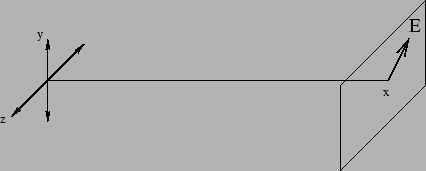



Next: Linear polarization
Up: lect_notes
Previous: Energy density, flux and
Contents
Consider a situation where the same electrical signal is fed to two
mutually perpendicular dipoles, one along the  axis and another along
the
axis and another along
the  axis as shown in Figure 19.1.
axis as shown in Figure 19.1.
Figure 8.1:
The resultant electric field at 
 |
We are interested in
the electric field at
a distant point along the  axis. The electric field is a
superposition of two components
axis. The electric field is a
superposition of two components
 |
(8.1) |
one along the  axis produced by the dipole which is aligned along the
axis produced by the dipole which is aligned along the
 axis, and another along the z axis produced by the dipole oriented
along the
axis, and another along the z axis produced by the dipole oriented
along the  axis.
axis.
Subsections
Physics 1st Year
2009-01-06

![]() axis. The electric field is a
superposition of two components
axis. The electric field is a
superposition of two components